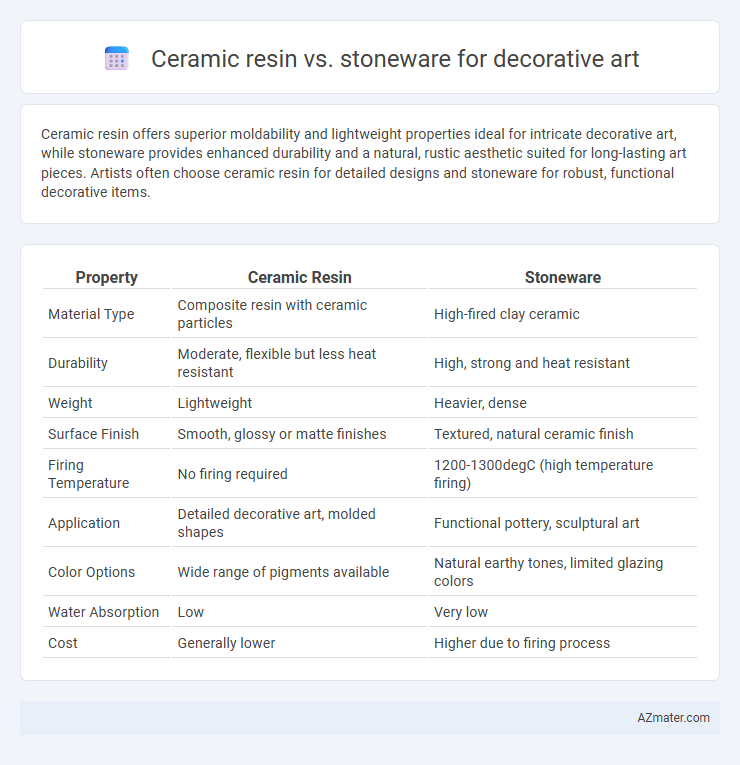Ceramic resin offers superior moldability and lightweight properties ideal for intricate decorative art, while stoneware provides enhanced durability and a natural, rustic aesthetic suited for long-lasting art pieces. Artists often choose ceramic resin for detailed designs and stoneware for robust, functional decorative items.
Table of Comparison
| Property | Ceramic Resin | Stoneware |
|---|---|---|
| Material Type | Composite resin with ceramic particles | High-fired clay ceramic |
| Durability | Moderate, flexible but less heat resistant | High, strong and heat resistant |
| Weight | Lightweight | Heavier, dense |
| Surface Finish | Smooth, glossy or matte finishes | Textured, natural ceramic finish |
| Firing Temperature | No firing required | 1200-1300degC (high temperature firing) |
| Application | Detailed decorative art, molded shapes | Functional pottery, sculptural art |
| Color Options | Wide range of pigments available | Natural earthy tones, limited glazing colors |
| Water Absorption | Low | Very low |
| Cost | Generally lower | Higher due to firing process |
Understanding Ceramic Resin and Stoneware
Ceramic resin is a versatile composite material combining resin with ceramic particles, offering lightweight durability and intricate detail for decorative art. Stoneware, a dense and durable clay fired at high temperatures, provides a natural, earthy aesthetic with excellent strength and thermal resistance. Understanding these differences helps artists choose between the smooth, moldable finish of ceramic resin and the robust, traditional appeal of stoneware for their creations.
Material Composition and Properties
Ceramic resin is a composite material composed of polymer resins combined with ceramic powders, offering lightweight durability and high malleability ideal for intricate decorative art. Stoneware, a type of dense, non-porous ceramic made from fired clay at high temperatures, provides excellent hardness, thermal resistance, and a natural, earthy aesthetic. While ceramic resin allows for easier molding and finer detail work, stoneware ensures superior durability and heat retention, influencing the choice based on functional and artistic requirements.
Aesthetic Qualities in Decorative Art
Ceramic resin offers a smooth, glossy finish with vibrant color options that enhance intricate decorative art details, making it ideal for contemporary and customized designs. Stoneware provides a rich, earthy texture with natural variations and matte finishes, lending authenticity and a timeless aesthetic to traditional and rustic decorative pieces. The choice between ceramic resin and stoneware directly impacts the visual depth and tactile appeal, influencing the overall artistic expression in decorative art.
Versatility and Artistic Techniques
Ceramic resin offers exceptional versatility in decorative art due to its malleable properties, allowing artists to experiment with intricate textures, fine details, and vibrant color applications that mimic natural materials. Stoneware, known for its durability and robust surface, excels in traditional sculpting techniques and is ideal for high-fired glazing, providing a rich, earthy aesthetic that enhances artisanal craftsmanship. Both materials support diverse artistic techniques, but ceramic resin enables more immediate and complex shaping while stoneware delivers timeless strength and tactile depth.
Durability and Longevity
Ceramic resin offers enhanced durability for decorative art due to its resistance to cracking and chipping, making it ideal for intricate designs and outdoor displays. Stoneware, fired at high temperatures, provides exceptional longevity and strength, ensuring that pieces can withstand wear and maintain their finish over time. Both materials excel in durability; ceramic resin is more flexible, while stoneware's density contributes to its lasting structural integrity.
Weight and Handling Considerations
Ceramic resin is significantly lighter than stoneware, making it easier to handle and ideal for intricate decorative art pieces that require fine detail and frequent movement. Stoneware is denser and heavier, offering durability and a solid feel but demanding more careful handling to avoid damage during transport or installation. Choosing between these materials depends on balancing the need for lightweight convenience versus the robustness and traditional texture provided by stoneware.
Surface Finishes and Textures
Ceramic resin offers a smooth, polished surface finish that enhances intricate details and allows for vibrant color application in decorative art, while stoneware presents a naturally textured, matte or semi-matte finish that highlights earthy, rustic aesthetics. The resin's versatility supports high-gloss or matte coatings, making it ideal for modern, sleek designs, whereas stoneware's coarse texture provides a tactile quality appealing in traditional and artisanal pieces. Surface durability differs as ceramic resin resists chipping and scratches better, maintaining its refined appearance longer compared to stoneware's porous and more fragile texture.
Cost Comparison for Artists
Ceramic resin offers a more affordable option for decorative art, with raw material costs typically lower than those of stoneware, which requires higher temperatures and longer kiln firing times, increasing energy expenses. Stoneware provides durability and a traditional aesthetic but demands greater investment in equipment and time, making it more expensive overall for artists on a budget. Choosing ceramic resin can significantly reduce production costs while still allowing for detailed sculptural work in decorative art.
Environmental Impact and Sustainability
Ceramic resin, often composed of synthetic polymers, tends to have a higher environmental footprint due to non-biodegradable components and energy-intensive manufacturing processes. Stoneware, made from natural clay and fired at high temperatures, offers greater sustainability through biodegradability and the use of abundant, non-toxic raw materials. Choosing stoneware for decorative art supports eco-friendly practices by minimizing chemical waste and promoting durability, making it a preferable option for environmentally conscious artists and consumers.
Choosing the Right Medium for Your Art
Ceramic resin offers versatility and ease of molding, making it ideal for intricate decorative art pieces requiring fine details and lightweight durability. Stoneware, characterized by its dense, fired clay composition, provides a robust and natural texture that enhances the tactile feel and longevity of sculptural artworks. Artists must consider the desired finish, weight, and durability when choosing between ceramic resin and stoneware to ensure the medium aligns with their creative vision and functional needs.

Infographic: Ceramic resin vs Stoneware for Decorative art
 azmater.com
azmater.com